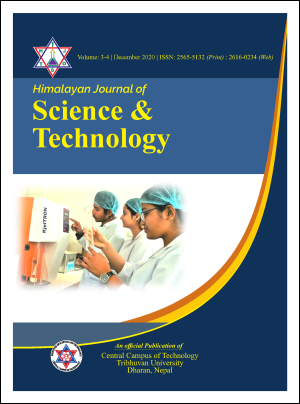Growth Performance of Clarias gariepinus on the Basis of Formulated Feed Supply
DOI:
https://doi.org/10.3126/hijost.v4i0.33863Keywords:
Aquaria, Local meterials, Pearson square methodAbstract
Best diet of the fish is the sole of production of aquaculture. Growth performance of Clarias gariepinus on the basis of formulated feed supply was carried out from 7th March to 6th May, 2019 in the laboratory of P.G.Campus, Biratnagar in which 130 juveniles (each of 10±0.11 g.) of catfish were cultured in 13 aquaria feeding with treatment diets having crude protein level 35%, 40%, 45% and 50% for treatment and commercial diet for control. There are no significant differences between the water quality parameters and body weight gain (p>0.05) in all treatments. The highest body weight gain (7.31±0.11 g; 65.20%) and SGR (13.051±1.15 g) was observed in fish fed with T C (45% protein level). This value was lowered than value of control(C) i.e. 7.59±0 g; 69.88% and 13.55±0 g respectively. Feed conversion ratio (FCR) was best (13.28±1.89 g) in T D (50% protein level feed). Its value was larger (7.52±1.11 g) in T C than C (7.15±0 g). Mortality rate was highest in T C and C i.e. 30% and lowest in T A and T B i.e. 23.33%. Weight gain of the fish increased with increasing protein level in diet till crude protein level 45% then it was dropped at the diet with protein level 50%. The best weight gain was observed in 7th week having crude protein level 45%. The diet with protein level 45% is suggested for farmers concerning the fish (Clarias gariepinus) in the aquaculture.
Downloads
Downloads
Published
How to Cite
Issue
Section
License
© Himalayan Journal of Science and Technology
All rights reserved.




